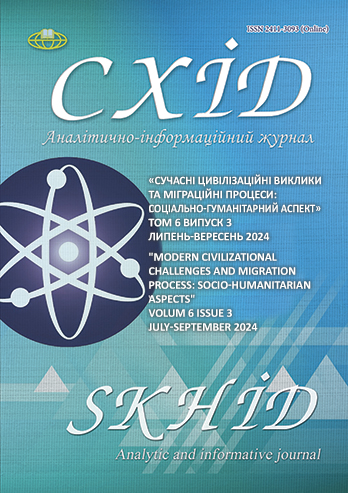Transit of Hindu Mythology: Role of Biographical Method in Multicultural Landscape
DOI:
https://doi.org/10.21847/2411-3093.638Keywords:
culture, memory, multiculturalism, values, philosophical turn, being, biography, biographical approach, identity, identification, mythologyAbstract
The study offers a biographical examination of the “Ramayana,” an ancient Indian epic renowned not only for its cultural significance and literary eminence but also for its scrutiny within the framework of modern philosophical discourse that includes a biographical dimension. In the “Ramayana,” we trace how conventional cultural archetypes, such as devotion, justice, and love, are revealed through distinct biographical circumstances and narratives. In the epic, each character serves as a bearer of specific archetypal attributes and concepts, which reflect diverse facets of human nature and are also distinct symbols embodying virtues, devotion, love, morality, evil, etc. With the help of mythological plots through biographical practices, people identify themselves with the characters of myths. In recent decades, there has been a popularization of modern adaptations of the “Ramayana” across India. The emergence of “new Indian mythmaking” and the renewed perception of profound archetypes within Indian culture coincides with the growing expansion of biographical and pseudo-biographical content in mass media. The protagonists of epics serve as foundational elements for the biographical strategies embraced by modern audiences, playing an integral role in shaping the culture of modern India and determining specific options for constructing a life course. In this article, we have examined contemporary interpretations of the “Ramayana” by writers such as Kavita Kané, Amish Tripathi, and Devdutt Pattanaik. In the works of these authors, one observes a transformation in the biographies of characters, shifts in their conduct, and even depictions of their emotional states, all of which reflect modern socio-cultural realities. This philosophical turn, characterized by the fusion of ancient myths with modern realities, values, and reader expectations, leads to a rethinking of traditional images, as well as a cultural dialogue between the East and the West.
Downloads
References
Atamaniuk, Z. (2023). Dukhovnist osobystosti yak proiav kulturnoho rozvytku [The Spirituality of the Individual as a Manifestation Cultural Development]. Naukove piznan-nia: metodolohiia ta tekhnolohiia, 1(51), 30–36. https://doi.org/10.24195/sk1561-1264/2023-1-5 (In Ukrainian)
Author Amish. (2015). The “Scion of Ikshvaku” Trailer by Amish [Video]. YouTube. https://youtu.be/k4xhu9MeI-zw?si=qudin7TfBjkE6OG
Brodetska, Yu. (2022). Metodolohichni metamorfozy suchasnoi filosofii: «nova ontolohiia» buttia [Methodo-logical metamorphosis of Modern Philosophy: a «New Ontology» of Being]. Filosofiia ta politolohiia v konteksti suchasnoi kultury, Vol. 14, 1(29), 3–7. https://doi.org/10.15421/352201 (In Ukrainian)
Golubovych, I., Menzhulin, V. & Popova, T. (2021). Bi-ohrafistyka [Biographistics]. In Velyka ukrainska entsyklopediia. https://vue.gov.ua/Біографістика (In Ukrainian)
Golubovych, I. & Menzhulin, V. (2021). Biohrafichnyi me¬tod [Biographical method]. In Velyka ukrainska entsy¬klopediia. https://vue.gov.ua/Біографічний_метод (In Ukrainian)
Golubovych, I. (2022). Fenomen biohrafii v kulturi: inteh-ratsiia doslidnytskykh stratehii [The phenomenon of bi-ography in culture: integration of previous strategies]. In S. P. Shevtsov (Ed.) Protsesy intehratsii i dyferentsiatsii v suchasnomu naukovomu ta filosofskomu znanni: kolekt. monohrafiia (pp. 213–233). Odeskyi natsionalnyi univer-sytet imeni I. I. Mechnykova. https://dspace.onu.edu.ua/items/119f244f-90de-49a6-911f-2fe24eee34eb (In Ukrainian)
Gotynyan-Zhuravlova, V. (2022). Multykulturalizm yak kliu-chovyi parametranalizu sotsialnykh I kultur-nykhiavyshch i protsesiv [Multiculturalism as a Key Pa-rameter of the Analysis of Social and Cultural Phenome-na and Processes]. Doksa. 2(38). 76–84. https://doi.org/10.18524/2410-2601.2022.2(38).¬283064 (In Ukrainian)
Eliade, M. (1954). Cosmos and History: The Myth of The Eternal Return. Harper & Brothers.
Kané, K. (2016) Lanka’s Princess. Rupa Publications.
Kané, K. (2014). Sita’s Sister. Rupa Publications. Kotak Mahindra partners with author Amish Tripathi (2015). Hans India. https://www.thehansindia.com/posts/index/Hans/2015-06-30/Kotak-Mahindra-partners-with-author-Amish-Tripathi/160564
Levchenko, V. (2022). Muzeinist u systemy pochuttiv kultur-noi pamiati [Musealization in the System of Senses of Cultural Memory]. Doksa. 1(37). 138–142. https://doi.org/10.18524/2410-2601.2022.1(37).¬281828 (In Ukrainian)
Pattanaik, D. (2017) Leader: 50 Insights from Mythology. Harper Business.
Sharma, M. (2023). 108 Names of Lord Shri Ram with Mean-ing. The Times of India. https://timesofindia.indiatimes.com/religion/mantras-chants/108-names-of-lord-shri-ram-with-meaning/articleshow/106011858.cms
The Ramayana of Valmiki. Vol. 1 (1952). (Hari Prasad Shas-tri, Trans.). Burleigh Press.
The Ramayana of Valmiki. Vol. 2 (1957). (Hari Prasad Shas-tri, Trans.). Burleigh Press.
The Ramayana of Valmiki. Vol. 3 (1959). (Hari Prasad Shas-tri, Trans.). Burleigh Press.
Tripathi, A. (2022). Ram: Scion of Ikshvaku. HarperCollins India.
van der Veer, P. (1989). The Power of Detachment: Disci-plines of Body and Mind in the Ramanandi Order. American Ethnologist, 16(3), 458–470. http://www.jstor.org/stable/645268
Downloads
Published
How to Cite
Issue
Section
License
Copyright (c) 2024 Марія Рижик, Інна Голубович

This work is licensed under a Creative Commons Attribution-NonCommercial-NoDerivatives 4.0 International License.
1. Authors bear responsibility for the accuracy of facts, quotations, numbers and names used.
2. Manuscripts are not sent back.
3. The publisher does not always agree with the authors' opinion.
4. The authors reserve the right to authorship of the work and pass the first publication right of this work to the journal under the terms of a Creative Commons Attribution-NonCommercial-NoDerivatives 4.0 International License. This license allows others to distribute (copy) the published work for non-commercial purposes, provided there is mandatory attribution to its authors and a link to the first publication in our journal.
5. The authors have the right to conclude separate supplement agreements that relate to non-exclusive work distribution in the form in which it has been published by the journal (for example, to upload the work to the online storage of the journal or publish it as part of a monograph), provided that the reference to the first publication of the work in this journal is included.

